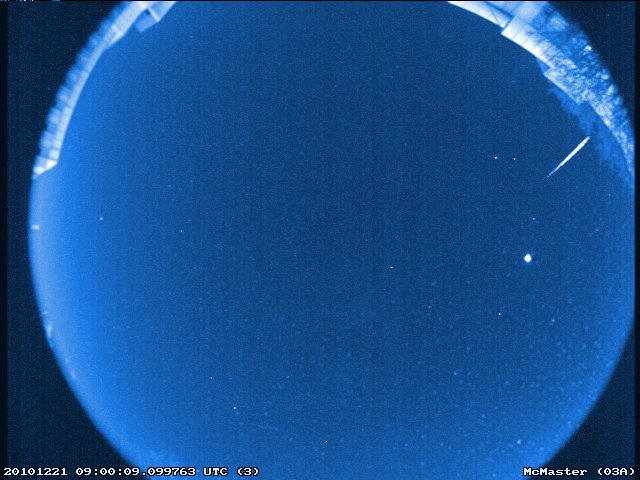The 2010 solstice lunar eclipse is one for the books, but check out these images from two cameras in the Canadian all-sky meteor camera network.These cameras are similar to the ones used for observation at NASA’s Marshall Space Flight Center: all-sky, black-and-white, and detecting bright meteors, or fireballs. Below are two stacked images of the eclipse:

Stacked image of the eclipse using images taken every five minutes from McMaster University
between 6:32 and 9:32 UT.

A similarly stacked image, combining pictures every five minutes between 5:27-9:37;
it was taken from Orangeville, ON, Canada.
Just as a reminder, the eclipse event timings in UT were:
- Partial begins: 6:33
- Total begins: 7:41
- Mid eclipse: 8:17
- Total ends: 8:53
- Partial ends: 10:01
So both cameras captured the full moon as it normally appears, then imaged it as it was eclipsed through the partial and total phases. Unfortunately, bad weather rolled in before the eclipse ended!
The Canadian cameras also detected meteors during the eclipse. Here are a few good ones:
The following two images were also taken from McMaster and Orangeville at about 7:38 UT, just before the total eclipse began, but after the partial eclipse had started. These pictures show an image of a meteor fairly close to the moon in the field of view.


The following three images were recorded from Elginfield, ON, Canada, McMaster, and Orangeville, respectively, at about 9:00 UT, just after the total eclipse phase ended, but before the partial eclipse ended. This meteor ablated by a height of 83 kilometers, or 52 miles.



Images courtesy of the Meteor Physics Group at the University of Western Ontario in London, ON, Canada
Text courtesy of Danielle Moser, NASA’s Marshall Space Flight Center, Meteoroid Environment Office
